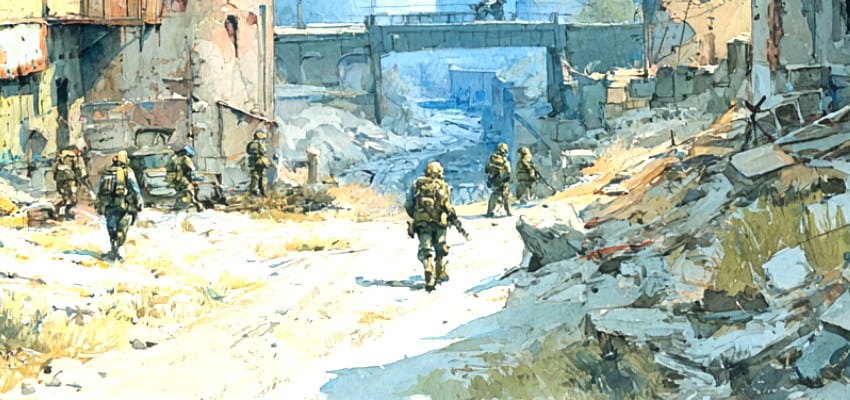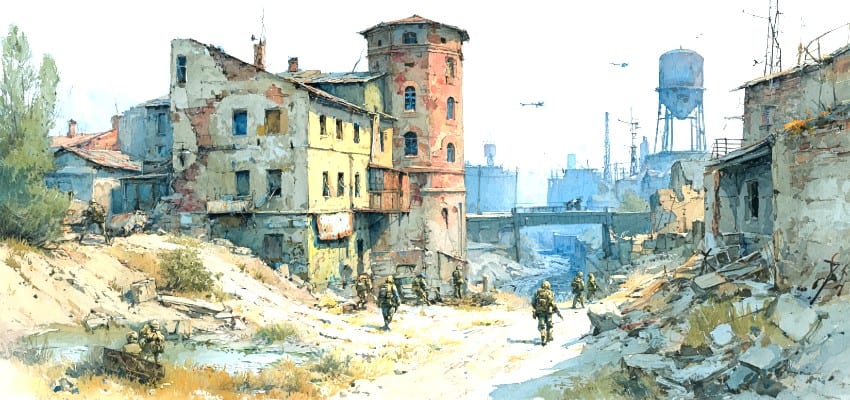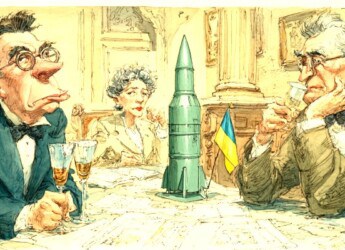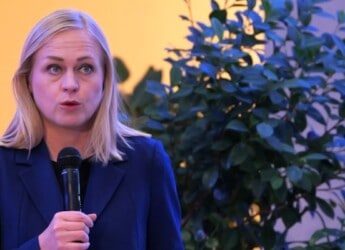Editor’s Note: This article delivers a comprehensive analysis of Russian diplomatic posturing and battlefield operations on October 27, 2025, a day that revealed the multifaceted nature of Moscow’s ongoing war strategy. Drawing from authoritative sources—including the Ukrainian General Staff, the 7th Rapid Response Corps, the Institute for the Study of War’s daily assessment, DeepState UA’s open-source battlefield mapping, and statements from Lithuanian officials on Belarus-origin airspace violations—the report offers a multidomain perspective on Russia’s hybrid campaign.
It also incorporates primary materials such as Foreign Minister Sergei Lavrov’s interview with Hungarian outlet Ultrahang, remarks by Russian Direct Investment Fund CEO Kirill Dmitriev, and public responses from U.S. President Donald Trump to Russia’s nuclear signaling. Together, these sources ground the analysis in real-time developments while exposing the strategic intent behind Russia’s military, legal, and informational maneuvers.
Informed by Center for Strategic and International Studies (CSIS) research into hybrid warfare escalation, and historical parallels to Russia’s post-2008 Georgia ceasefire manipulation, the article examines the legal ambiguity and information warfare techniques used to destabilize, mislead, and reshape diplomatic expectations. These insights reflect ComplexDiscovery’s mission to illuminate the intersections of information governance, legal technology, and business intelligence in environments shaped by conflict and complexity.
All battlefield movements, diplomatic statements, and casualty figures reflect publicly available reporting as of 6:00 PM Eastern Time, October 27, 2025. As with all conflict reporting, certain figures, tactical descriptions, and assessments are based on open-source intelligence and official statements that may evolve as additional verification emerges. Comparative references and interpretive conclusions are provided for analytical context and do not imply definitive legal or operational judgments.
For those seeking to grasp the full scope of this evolving landscape, the Institute for the Study of War’s comprehensive updates serve as an invaluable resource.
Content Assessment: Russia's Multi-Domain Strategy: Hybrid Pressure, Legal Ambiguity, and the Battle for Pokrovsk
Information - 94%
Insight - 100%
Relevance - 92%
Objectivity - 93%
Authority - 94%
95%
Excellent
A short percentage-based assessment of the qualitative benefit expressed as a percentage of positive reception of the recent article from ComplexDiscovery OÜ titled, "Russia's Multi-Domain Strategy: Hybrid Pressure, Legal Ambiguity, and the Battle for Pokrovsk."
Background Note: ComplexDiscovery’s staff offers distinctive perspectives on the Russo-Ukrainian war and Middle Eastern conflicts, informed by their military experience on the West German, East German, and Czechoslovakian borders during the Cold War, as well as in Sinai as part of Camp David Accord compliance activities, during the timeframe of the Persian Gulf War. This firsthand regional knowledge has been further enhanced by recent staff travels to Eastern European countries, including Estonia, Finland, Latvia, Lithuania, and Poland. These visits have provided up-to-date, on-the-ground insights into the current geopolitical climate in regions directly impacted by the ongoing conflict.
Combined with cybersecurity, information governance, and eDiscovery proficiency, this multifaceted experience enables comprehensive analysis of these conflicts, including the critical impact of cyber warfare, disinformation, and digital forensics on modern military engagements. This unique background positions ComplexDiscovery to provide valuable insights for conflict-related investigations and litigation, where understanding the interplay of technology, data, and geopolitical factors is crucial.
Russo-Ukrainian Conflict Update*
Russia’s Multi-Domain Strategy: Hybrid Pressure, Legal Ambiguity, and the Battle for Pokrovsk
ComplexDiscovery Staff
The Negotiation That Isn’t
Kirill Dmitriev, head of Russia’s Direct Investment Fund and a central figure in Kremlin peace negotiations, revealed the core obstacle blocking any settlement on October 27 when he confirmed that Ukraine has proposed freezing the conflict along current lines—and that Moscow rejects this entirely. Speaking to Russian media, Dmitriev acknowledged Ukraine’s modified negotiating stance while simultaneously reiterating Russia’s insistence on seizing all territory within the four oblasts Moscow claims to have annexed: Luhansk, Donetsk, Kherson, and Zaporizhzhia.
The admission exposes what Russian officials frame as openness to dialogue for what it is: a demand for Ukrainian capitulation dressed in the language of peace. This pattern mirrors Russia’s approach following the 2008 Georgia conflict, when Moscow added territorial and security provisions to an originally four-point French-mediated ceasefire, then violated withdrawal terms while consolidating control over South Ossetia and Abkhazia. The parallel suggests Russian negotiating positions function as tactical instruments rather than good-faith compromises—changeable demands designed to transfer blame for diplomatic failure while Russian forces pursue maximalist aims on the ground.
Even as Dmitriev spoke, urban combat raged in Pokrovsk, where Ukrainian forces confronted approximately 200 Russian troops who had infiltrated the eastern Donetsk city in small groups. The contrast between Moscow’s diplomatic posturing and battlefield reality on October 27 illustrated a war fought simultaneously through information operations and attritional urban combat.
Coordinated Pressure Across Multiple Domains
Russia staged a coordinated messaging campaign on October 27 designed to shift responsibility for stalled negotiations onto Washington and its European allies. Foreign Minister Sergei Lavrov’s interview with Hungarian media outlet Ultrahang served as the centerpiece, accusing the United States of abandoning diplomatic progress allegedly made before August’s Alaska summit and framing Russia as ready to cooperate if only America would initiate the next step. Lavrov dismissed immediate ceasefire proposals as schemes allowing Ukraine to rearm, restating preconditions that amount to Ukrainian defeat: cessation of Western weapons transfers and Ukrainian withdrawal from the four annexed oblasts.
The foreign minister also invoked historical claims to territories beyond those four regions, describing Odesa as a “Russian” city rooted in 18th-century settlement under Catherine the Great—rhetoric telegraphing territorial ambitions extending to Ukraine’s Black Sea coast and complicating any notion that Russia’s war aims are geographically limited or negotiable.
Nuclear signaling accompanied the diplomatic theater. After President Trump publicly characterized Russia’s test of the nuclear-powered Burevestnik cruise missile as “inappropriate,” Kremlin spokespeople alternated between minimizing the test’s bilateral implications and having surrogates threaten that the weapon could hold North America at risk should the United States provide Ukraine with certain missile systems. The performance echoed Russia’s November 2024 use of the Oreshnik intermediate-range ballistic missile against Dnipro—another exercise in coercive messaging that ultimately lost traction. Trump’s dismissive response suggests diminishing Western sensitivity to Russian nuclear posturing compared to 2022-2023, when such threats generated more overt policy caution.
The pressure campaign extended to NATO’s northeastern periphery. Balloons entering Lithuanian airspace from Belarusian territory forced multiple suspensions of operations at Vilnius Airport over several days, prompting Lithuanian authorities to indefinitely close most land border crossings with Belarus and vow kinetic countermeasures against future incursions. Lithuania’s prime minister condemned the activity as “deliberate escalation of hybrid warfare”, a characterization consistent with documented patterns. According to a March 2025 CSIS database tracking Russian subversive actions, the number of Russian shadow war attacks against European and U.S. targets nearly tripled between 2023 and 2024, with transportation infrastructure, government facilities, and critical systems as primary targets. The Belarus balloon operations fit this broader strategy of testing NATO gray zones—actions below Article 5 armed attack thresholds but designed to impose costs, complicate decision-making, and normalize persistent aggression.
These parallel efforts—diplomatic blame-shifting, nuclear intimidation, and hybrid destabilization—represent not isolated initiatives but components of an integrated Russian strategy to fracture Western resolve and coerce policy shifts favorable to Moscow’s war aims, all while conventional forces grind forward in eastern Ukraine.
Pokrovsk: Infiltration, Force Concentration, and Ukrainian Adaptation
The most consequential fighting on October 27 centered on Pokrovsk, where Russian forces have surrounded the city from three sides, leaving approximately a 15-kilometer gap for Ukrainian logistics and reinforcement. Ukrainian President Volodymyr Zelensky reported that Russia outnumbers Ukrainian defenders eight-to-one in the Pokrovsk sector, having concentrated extraordinary combat power against the city. “Imagine how many Russian forces are there,” Zelensky told journalists on October 27. “But at the same time, they have not achieved the planned result”.
Geolocated footage showed Russian units advancing along Nakhimova Street in western Pokrovsk, even as Ukrainian forces conducted counterattacks to the north near Rodynske. The Ukrainian General Staff reported that around 200 Russian troops had accumulated within Pokrovsk after penetrating in pairs and small teams, occupying basements and damaged structures while awaiting reinforcement. Ukraine’s 7th Rapid Response Corps, responsible for Pokrovsk’s defense, stated that infiltrating groups “are not trying to gain a foothold, but intend to move further north” to disperse Ukrainian defenses and block land logistics corridors. The corps reported killing approximately 40 Russian troops in Pokrovsk on October 25-26 through active counter-sabotage operations.
This pattern of small-unit infiltration, basement occupation, and incremental consolidation mirrors Russian urban warfare tactics refined during the protracted battles for Mariupol and Bakhmut. In those cities, Russian forces employed assault detachments—specialized battalion-level formations designed for attacking fortified positions and urban areas—that would penetrate in small groups, establish temporary strongpoints in heavy infrastructure and subterranean spaces, then attempt to link up with follow-on forces. Ukrainian defenders at Mariupol held for over 80 days against forces five to eight times larger by leveraging the city’s industrial buildings and underground networks. Bakhmut saw months of grinding combat as Russian forces abandoned encirclement attempts in favor of costly direct urban assault.
The difference in Pokrovsk appears to be Ukrainian adaptation. The 7th Corps emphasized that Russian infiltrators have not achieved control over any district of the city, and that defenders are systematically locating and eliminating small groups before they can consolidate or receive armored support. Ukrainian forces reported destroying 64 Russian troops and multiple armored vehicles along the corps’ defense line on October 25-26 alone, repelling 42 attacks without yielding their objectives. One Ukrainian military analyst compared Russian activity near Pokrovsk to the level seen during the capture of Avdiivka in early 2024, describing the relative stability as “a major achievement” of Ukrainian coordination.
The 2nd Combined Arms Army, identified as Russia’s principal striking formation in the sector, reportedly received waves of manpower reinforcements totaling several thousand troops in recent weeks and concentrated efforts on southern and western Pokrovsk approaches. Simultaneously, the 51st Combined Arms Army reduced activity west of the Kazennyi Torets River in the Dobropillia area, redirecting attention toward Myrnohrad and Rodynske. This reweighting suggests Russian operational priorities: seize urban terrain inside Pokrovsk, stretch Ukrainian defenses across multiple axes, then resume broader envelopment operations.
Ukrainian shaping operations complicated Russian logistics on October 27. A precision strike on the Belgorod Reservoir dam in Russia’s Belgorod region dropped water levels and flooded Russian positions near Grafovka, disrupting elements of the 128th and 136th Motorized Rifle Brigades and a Rosgvardia unit. Ukrainian military spokesmen assessed the strike degraded Russian logistics and reduced offensive tempo east of the Siverskyi Donets River, underscoring riverine infrastructure as a critical vulnerability for Russian forces sustaining operations northeast of Kharkiv.
Across the broader front, geolocated evidence confirmed Ukrainian advances north of Pishchane in the Kupyansk direction and the liberation of Yehorivka in the Hulyaipole sector, even as Russian sources claimed flag-raising in Pryvilne and Novomykolaivka to the northeast. In the Dobropillia area, Ukraine reported liberating Kucheriv Yar and Sukhetske over the preceding ten days. These localized Ukrainian gains contrast with Russian maximalist territorial rhetoric, illustrating the gap between Moscow’s stated war aims and actual incremental battlefield progress.
Russia launched approximately 100 strike drones overnight on October 26-27, targeting energy infrastructure in Zaporizhzhia and Pavlohrad districts and residential areas in multiple cities. Ukraine reported intercepting 66 drones while remaining strikes hit nine locations. Ukrainian electronic warfare observers documented a tactical innovation: some Shahed-type drones carried anti-tank mines suspended beneath their airframes—timed munitions rendering crash sites hazardous to first responders and civilians. The adaptation represents an evolution in autonomous weapons employment with implications extending beyond immediate tactical effects to broader questions of compliance with international humanitarian law governing indiscriminate weapons.
Information Operations, Legal Precedents, and Strategic Stalemate
October 27 revealed dynamics that will shape the war’s trajectory through winter and beyond. Russia’s diplomatic messaging seeks to manufacture leverage and fracture Western support while rejecting substantive compromise—a pattern with historical precedent. Following the 2008 Russo-Georgian War, Russia successfully added territorial and security provisions to French President Nicolas Sarkozy’s ceasefire framework, then systematically violated withdrawal obligations while consolidating control over disputed territories. The ceasefire, initially designed to restore pre-conflict lines, instead legitimized Russian occupation through ambiguous language about “additional security measures” that Moscow interpreted as indefinite presence. Dmitriev’s October 26 statements suggest Russia is attempting a similar approach in Ukraine: frame Ukraine’s willingness to freeze the conflict as progress while Moscow’s rejection of current lines as principled defense of “constitutional” claims.
Those constitutional claims carry legal implications extending beyond battlefield geography. Russia’s invocation of sham referendums as justification for annexing Ukrainian territory—and Lavrov’s expanded historical arguments encompassing Odesa—create precedent challenges for future war crimes prosecutions and reparations frameworks. If Russia treats occupied Ukrainian territory as constitutionally Russian, Moscow will argue that strikes against military targets in those areas constitute attacks on Russia proper, potentially complicating third-party legal assessments of proportionality and distinction under international humanitarian law. The rhetorical expansion to Odesa signals that even a negotiated settlement addressing the four annexed oblasts would not satisfy Russian territorial maximalism, rendering ceasefire agreements unstable absent enforcement mechanisms.
The information warfare dimension also warrants scrutiny. Lavrov’s choice of Hungarian outlet Ultrahang for his October 26 interview represents deliberate target selection within a broader information operation. Hungary, under Prime Minister Viktor Orbán, has opposed EU sanctions on Russia and resisted unified Western support for Ukraine, making Hungarian media an effective vector for narratives portraying the United States as obstinate and Russia as reasonable. This segmentation—delivering tailored messages through sympathetic channels—mirrors documented Russian information warfare doctrine emphasizing audience-specific narratives over broad broadcast.
Yet the effectiveness of Russian messaging appears uneven. Trump’s dismissal of the Burevestnik test as “inappropriate” and his public call for Putin to “end the war, not test missiles” suggest declining Western responsiveness to nuclear coercion. This response contrasts with 2022-2023, when Russian nuclear rhetoric generated measurable policy caution regarding weapons transfers to Ukraine. The diminishing return on nuclear intimidation may reflect Western adaptation to persistent threats or calculation that Moscow’s actual escalation risk remains bounded by self-interest.
Belarus-origin balloon incursions into Lithuanian airspace illustrate hybrid warfare’s evolution into persistent gray-zone pressure. NATO members have acknowledged since the 2016 Warsaw Summit that cumulative hybrid activities could constitute armed attack triggering Article 5 collective defense. Lithuanian authorities’ characterization of the balloons as “deliberate escalation of hybrid warfare” tests whether NATO will develop graduated response mechanisms matching the escalatory logic of hybrid campaigns, or whether the Alliance’s primarily defensive posture will continue failing to impose costs sufficient for deterrence. The CSIS database documenting the near-tripling of Russian shadow war attacks between 2023 and 2024 suggests current Western countermeasures have proven inadequate.
On the ground, the battle for Pokrovsk encapsulates the war’s essential character: Russian forces willing to accept extraordinary casualties for incremental territorial gains against Ukrainian defenders who leverage tactical adaptation, Western-supplied precision systems, and knowledge of urban terrain to impose costs disproportionate to Russia’s advances. Zelensky’s assessment that Russia “has not achieved the planned result” despite eight-to-one numerical superiority reflects the gap between Russian force concentration and operational effectiveness. Whether Ukrainian defenses can sustain this ratio through winter as Russian reinforcements flow into the sector—and whether Western ammunition and air defense supplies arrive at rates sufficient to support Ukrainian adaptation—will determine whether Pokrovsk becomes another Mariupol or whether Russia’s assault culminates short of its objectives, as earlier attempts to encircle the city did.
October 27 thus presented not a single decisive shift but a cross-section of the war’s grinding reality: Russia pursuing maximalist aims through military attrition and multidomain pressure while Ukraine seeks to impose costs sufficient to force Moscow toward genuine negotiation, and Western governments navigate between supporting Kyiv’s defense and avoiding direct confrontation with a nuclear-armed Russia. The outcome remains contested on urban streets, in diplomatic backchannels, and across the information space—a war fought simultaneously on multiple planes, with each domain influencing but not determining the others.
Postscript: Strategic Relevance to the eDiscovery and Information Risk Ecosystem
The events of October 27, 2025, offer more than a geopolitical snapshot—they expose a shifting landscape where war, law, and information collide in ways that directly affect cybersecurity, information governance, and eDiscovery professionals. Russia’s approach to diplomacy and combat is not isolated to the front lines of Pokrovsk; it is emblematic of how information is used as a weapon, and how legal constructs are manipulated to justify aggression and obscure accountability.
At a strategic level, the fusion of conventional warfare with narrative warfare reveals a world where disinformation and data manipulation are deployed with the same intensity as artillery. Understanding this interplay is no longer optional—it’s essential for professionals tasked with safeguarding systems, managing sensitive data, and interpreting the digital trails left by adversarial actors. The manipulation of public perception, legal claims, and media channels parallels the threats faced by organizations combating deepfakes, data leaks, and coordinated influence campaigns.
Operationally, Russia’s coordinated use of legal rhetoric, information operations, and infrastructure targeting presents a model of multidomain pressure that mirrors cyber-physical threats in the private sector. For professionals managing data governance and compliance, this underscores how vulnerable the integrity of information becomes in contested environments. Chain of custody, attribution, and trust in digital evidence can all be eroded by adversaries who understand the power of ambiguity.
On the tactical front, innovations like drones dropping anti-tank mines suggest how emerging technologies can blur the lines between combat systems and everyday digital tools. The use of autonomous platforms in warfare today foreshadows their use in asymmetric attacks on infrastructure tomorrow—raising urgent questions about incident response, legal discovery, and ethical data management in crisis scenarios.
This isn’t just a war fought over territory—it’s a conflict over truth, control, and the future of information itself. For those tasked with protecting, interpreting, and governing that information, the lessons from October 27 are immediate and enduring.
Assessed Control of Terrain Map for October 27, 2025
October 27 2025 - Accessed Control of TerrainAbout the Institute for the Study of War Research Methodology
ISW’s research methodology relies on both primary and secondary sources, enabling researchers to develop a comprehensive understanding of the situation on the ground. In order to analyze military and political developments in any given area, ISW’s research analysts must wholly understand the systems of enemy and friendly forces. They must also understand the population demographics, physical terrain, politics, and history of that area. This lays the analytical foundation for understanding the reasons for particular developments and fulfilling their assigned research objectives. ISW analysts also spend time in places like Iraq, Afghanistan, and elsewhere in order to gain a better understanding of the security and political situation and to evaluate the implementation of current strategies and policies. Their researchers compile data and analyze trends, producing a granular analysis of developments in areas of research, producing an accurate, high-resolution, timely, and thorough picture of the situation. ISW’s research methodology guarantees its success and commitment to improving the nation’s ability to execute military operations, achieve strategic objectives, and respond to emerging problems that may require the use of American military power.
About the Institute for the Study of War
The Institute for the Study of War advances an informed understanding of military affairs through reliable research, trusted analysis, and innovative education. They are committed to improving the nation’s ability to execute military operations and respond to emerging threats in order to achieve U.S. strategic objectives. ISW is a non-partisan, non-profit, public policy research organization.
Learn more, get involved, and contribute today.
News Sources
- Russian Offensive Campaign Assessment, October 27, 2025 – Institute for the Study of War (ISW)
- Russian troops outnumber Ukraine 8-1 in Pokrovsk sector, Zelensky says – Kyiv Independent
- Russian Envoy Says U.S., Russia, And Ukraine Are Close To A ‘Diplomatic Solution’ To War In Ukraine – Radio Free Europe/Radio Liberty (RFE/RL)
- Russia’s Shadow War Against the West – Center for Strategic and International Studies (CSIS)
- Lithuania to shoot down smuggling balloons, PM warns – BBC
Assisted by GAI and LLM Technologies
* Sourced and shared with permission from the Institute for the Study of War (ISW).
Additional Reading
- From Dissent to OSINT? Understanding, Influencing, and Protecting Roles, Reputation, and Revenue
- Data Embassies: Sovereignty, Security, and Continuity for Nation-States
Source: ComplexDiscovery OÜ



























